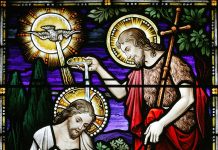
by Cullen Schippe
Memories are the breadcrumbs that mark a trail through life. Sights, smells, sounds, and feelings can conjure up memories and bring the past into sharp focus.
Memory is an art. People who are artists of memory are able to enjoy the good times and learn from the bad times. Armed with their memories, they are alive for the present and hope for the future.
Nostalgia, on the other hand, turns the fine art of remembering into the false sense that the past was always better than the present and that the future is the enemy.
Sacred Scripture holds the foundational memories of the People of God. In the canon of Scripture are the events, sayings, songs, and teaching that formed a community, that revealed God in human history, and that taught the need for undying love. Although reading Scripture may provide a journey back in time, it can never be an exercise in nostalgia. The Bible is not a book for then; it is a message for now.
As a catechist, you are called to be an artist of memory—to break open the Scriptures for those you teach and to show them that the words of the Bible are alive in the present and provide hope for the future. It is necessary for every catechist, therefore, to be formed by the Word of God.
A catechist who is formed by the Word of God is most definitely a person of the Gospel—a bearer of Good News. The Greeks had a great name for a bearer of good news: evangelist. The National Directory for Catechesis positions the ministry of catechesis within the mission all Christians have to go and teach all nations. “Catechesis will always draw its content from the living source of the word of God transmitted in Tradition and the Scriptures, for ‘sacred Tradition and sacred Scripture make up a single sacred deposit of the word of God, which is entrusted to the Church’” (n. 18).
No artist grabs a brush and instantly paints the Mona Lisa. Rather, true art is built on discipline. If you as a catechist want to become an artist of the memories that bind the faith community to Jesus Christ and his Church, you also need to be immersed in the Word of God. Catechists formed by the Word will maintain a certain very simple discipline that I like to call the Good News habit.
Here is a five-step plan that can be a method for both getting into the habit and growing in the artistry needed to be a bearer of Good News:
1. Read the Good News. The power of the Gospel means to you little if left unread.
2. Know the Good News. Be anxious to know all you can about the message of Jesus, what it means, how it has been lived, and what you can do about it.
3. Love the Good News. A person with the Good News habit gets excited about spending time with the Gospel. Loving the Gospel also means loving the Word made flesh—Jesus Christ.
4. Share the Good News. A person with the Good News habit is not shy about talking about it, having questions about it, using it as a point of reference in conversation, or reading it with friends and family.
5. Be the Good News. A person with the Good News habit is a living witness to the Word of God whose behavior reflects the message of the Gospel.
Catholics centered in the Eucharist also celebrate the Good News. The regular and structured reading of Scripture provided by the Sunday and daily lectionaries keep the foundational memories alive throughout the year. Through them, people of faith can enjoy the good times, learn from the bad times, be alive to faith opportunities in the present, and work for a faith-filled future.
So grab your brush and palette and prepare to be an artist of memory. Your canvas is made up of the hearts and minds of those you teach. The result of your artistry will be Catholics who are formed in the Word and who are living portraits of Jesus Christ.
Cullen Schippe has been in Catholic publishing for over 40 years and currently serves as Vice-President of Religious Education for the Peter Li Education Group. He co-authored (with Chuck Stetson) and served as general editor of The Bible and Its Influence (BLP Publishing, 2005). E-mail Cullen at cs******@pe*****.com.
Copyright 2010, Bayard, Inc. All rights reserved. This article is protected by United States copyright and other intellectual property laws and may not be reproduced, rewritten, distributed, redisseminated, transmitted, displayed, published or broadcast, directly or indirectly, in any medium without the prior written permission of Bayard, Inc.
This article was written by the Catechist Staff and appeared in Catechist magazine, December 2010.
Image Credit: Shutter Stock 387075394



